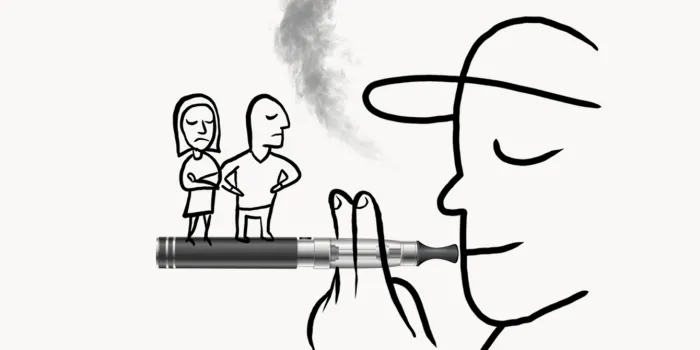It’s a pervasive problem facing young people. More than 2 million U.S. students in grades six to 12 vape, with e-cigarettes the most used tobacco product by the group, according to the 2022 National Youth Tobacco Survey.
Vaping is the use of an electronic device (e-cigarette) that heats a liquid into an aerosol that is inhaled. The liquid often has nicotine but also can have THC, the ingredient in marijuana that produces the “high.” Even e-cigarettes that claim to be tobacco-free contain some nicotine. E-cigarettes often look like actual cigarettes but can be shaped like a USB flash device or a pen.
Signs Your Kid Is Vaping
The Partnership to End Addiction says to look for these clues if you suspect your child is vaping:
- Smell — many e-cigarettes add flavoring, which produces a light scent
- Strange packages showing up for your teen; check your credit card for unknown charges
- Increased thirst, loss of appetite, nosebleeds, and headaches
- Equipment in their room that you can’t identify
- Cutting back on caffeine; vaping causes sensitivity to the stimulant
- Increased irritability and anxiety and difficulty concentrating
Vaping’s Effects on Teens
Parents need to know that vaping can be detrimental to growing bodies and minds.
“There are many serious health effects, including coughing, wheezing, seizures, and vomiting. There is also a potential for severe lung injury,” says Pat Aussem, associate vice president of consumer clinical content development for the Partnership to End Addiction.
Truth Initiative, a public health organization devoted to preventing tobacco use and nicotine addiction, says nicotine can affect key brain receptors and make it easier for youths to become addicted. It can harm brain development, exacerbate depression and anxiety, and increase stress.
Vaping Withdrawal Symptoms
Teenagers have susceptible brains and are at a very impressionable age. When they quit vaping, their bodies and brains must get used to the lack of nicotine in their system. This is called nicotine withdrawal. The side effects of nicotine withdrawal can be uncomfortable and can trigger further cravings for the substance. Common nicotine withdrawal symptoms include:
- Feeling irritable, restless, or jittery
- Having headaches
- Increased sweating
- Feeling sad or down
- Feeling anxious
- Feeling tired or groggy
- Having trouble thinking clearly or concentrating
- Having trouble sleeping
- Feeling hungry
- Having intense cravings for e-cigarettes
Concerns for Teens with Hemophilia
Vaping products containing nicotine and THC have been associated with a type of lung injury that has its own name: e-cigarette or vaping use-associated lung injury, or EVALI.
“Given reports of diffuse alveolar hemorrhage [bleeding in the lungs], there is concern that people with bleeding disorders would be at higher risk for hemorrhage and have increased severity of bleeding,” says Stephanie Prozora, M.D., pediatric medical director of the Yale Hemophilia Treatment Center. “Available data suggest vaping THC may specifically worsen bleeding risk.”
How to Address This with Your Teen
If you discover that your teen is vaping, find out why they vape and how it makes them feel. Are they bored? Suggest a new activity they might enjoy. Are they trying to self-medicate to address a mental health issue? Connect them with a therapist. Are they feeling pressure to fit in with peers? Give them an out: If they are with someone who is vaping and they’re uncomfortable, have them text you a code, and you can call right back with an excuse to pick them up.
Also, teach your teen about the health problems vaping can cause. Remind them of how this can interfere with what they want to do in life.
Finally, if they are addicted, help them quit. Resources are available from Truth Initiative, Smokefree.gov, and the Partnership to End Addiction.
More tips to help your household: HemAware has plenty of resources for the health issues facing your family, which you can find here.

